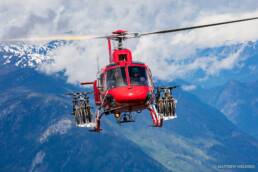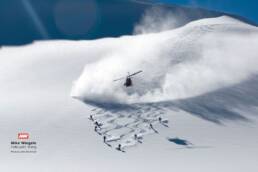Two years ago we wrote about how one Revelstoke company had invented a long-line rack for heli-biking. Now, Whistler-based Blackcomb Aviation has devised another kind of helicopter solution for bike bagging peaks. Ryan Stuart reports.
Heli-biking makes sense. Like its skiing cousin, the helicopter takes the work out of getting to the top, where the fun part begins. The problem—unlike the helicopter-mounted basket that flies side-car to carry skis and poles, there was no certified way to carry bikes on a bird. Groups wanting to get heli-dropped traditionally forked out for two trips: one to carry the riders and another to carry the bikes. Tied together and slung underneath, the bikes took a beating, especially as they touched down on a rocky summit.
Now, a new helicopter bike rack promises to send the fledgling niche of heli-biking to new heights. In August 2016, Transport Canada approved the rack designed by Aero Design in Powell River, British Columbia. Approval in the United States is in the works. It uses the same brackets as the ski baskets and easily clips in and out of place. It carries three bikes per side as gently as a car-rack and cuts shuttle costs by a third.
“The rack is going to change heli-biking drastically,” says Jordy Norris, the sales and marketing manager at Whistler-based Blackcomb Aviation. “Right now, not many people know heli-biking is a thing, but I think it will be as well-known as heli-skiing soon.”

All photos taken by Mathew MelsnessBlackcomb Aviation is the proud owner of the first Aero Design heli-rack, a by-product of their partnership on the project. Norris figures helicopters have shuttled mountain bikers for at least 15 years in British Columbia, first on Disneyland, a long descent near Squamish, and then from the summit of Rainbow Mountain, across the valley from Whistler. About a decade ago, Retallack Lodge, a snowcat operation in the Selkirk and Purcell Mountains, built downhill trails and began summer moonlighting as a heli-biking lodge. More recently, Blackcomb Aviation started flying riders to a summit above the Tenquille-Owl Lake Recreation Area near Pemberton. Two years ago, online giant PinkBike.com published a story about riding Disneyland. Demand for whirlybirds exploded.
Blackcomb Aviation approached Aero Design looking for an alternative to long-lining bikes. While there were existing heli-bike racks, none met Canadian standards, some of the strictest in the world, or Blackcomb’s needs, fast mounting to accommodate their varied summer business. The two companies collaborated on the design, which was approved in August 2016. Norris says the rack reduces the cost of a five-rider shuttle to the summit of Rainbow Mountain by 69%.
“We are at the forefront of a new industry,” says Norris. “With that comes responsibility. If we do it right from the start, we can set the standard for the future.”
Already, hikers are waving their poles in protest in Pemberton. That heli-drop trail exits into a popular hiking area. Increased helicopter flights, trail braiding, off-trail riding and traffic had wildlife and hiking advocates concerned. A compromise led to Blackcomb Aviation helping to build a trail for the bikers.
“The new trail was a bitter-sweet compromise,” says David Harkley, trail coordinator with the Pemberton Wildlife Association. “We object to the current level of activity, which operates largely without regulation.”
These concerns are on Norris’s mind too. Blackcomb Aviation is considering expanding the terms of its tenure to allow mountain bike guiding and building new trails. Avoiding conflicts with other users, wildlife and sensitive habitat is the first priority in the search for where to build and ride, says Norris.
“Once heli-biking is fully set up, we want everyone happy with it,” he says. “We want to do it right, and we want everyone to think we did it in a positive way.”
For a personal account of what heli-biking is like, check out online editor Vince Hempsall’s article called “Fly Joy.”
Ryan Stuart
Ryan Stuart has been fascinated by the natural world since he was a kid, and he’s now sharing this interest through his freelance writing, which he does from Comox on Vancouver Island, British Columbia.
Related Stories
Honest Review: Flylow Shaw Mountain Biking Shirt
Editor Vince Hempsall takes the Flylow Shaw mountain biking shirt for a rip. This is his honest review. Flylow is an…
The North Face teams up with Mike Wiegele Heli
Spend an average of 120+ days in the mountains every winter as a heli-ski guide and you see a lot of sh*t. Not only…
The North Face teams up with Mike Wiegele Heli
Spend an average of 120+ days in the mountains every winter as a heli ski guide, and you see a lot of sh*t. Not only…






